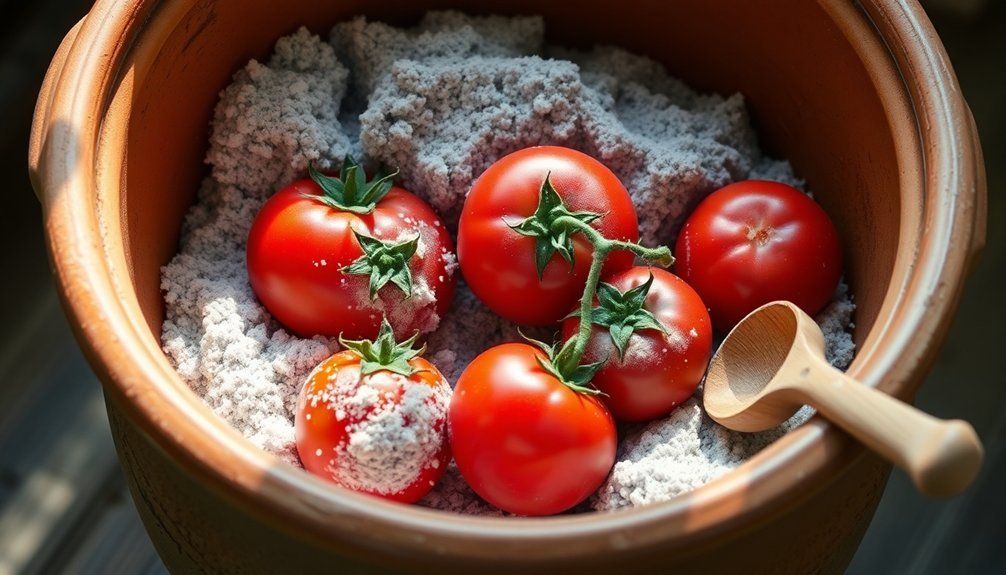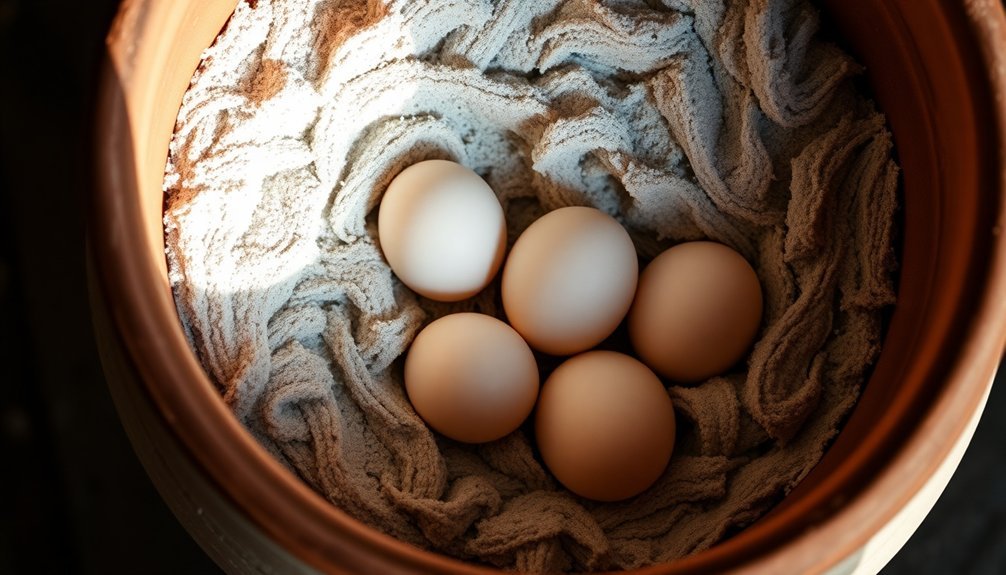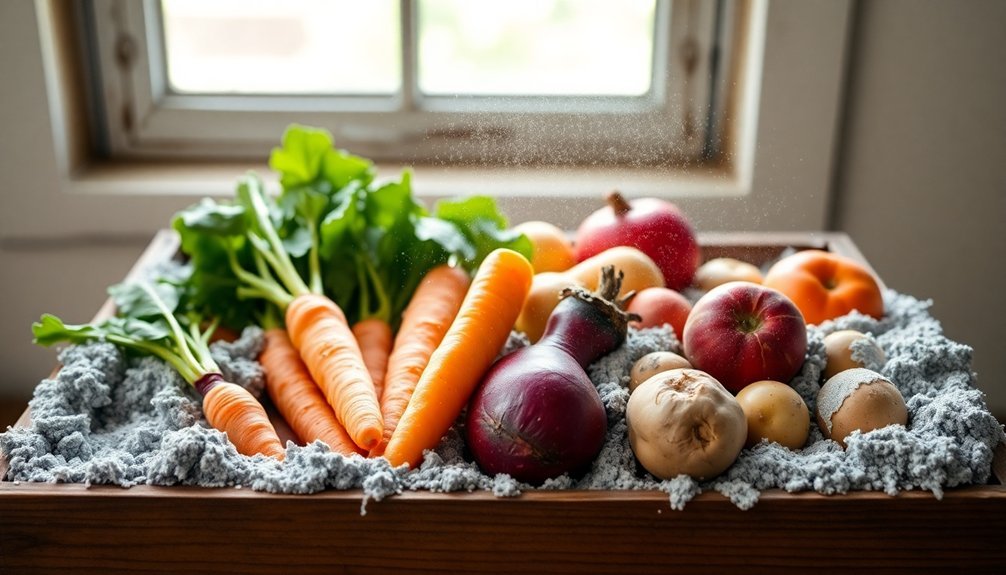You can preserve several types of food using finely sifted hardwood ash as a natural preservative. For tomatoes, layer them stem-side down between ash in a paper-lined container for up to six weeks of storage. With hard cheeses like Gruyere, place thick slices in a stoneware crock covered in ash to prevent mold growth for up to three months. Fresh, unwashed eggs will keep for around eight months when completely buried in wood ash inside a ceramic container. While these traditional methods require specific techniques and conditions, they'll help you maintain a sustainable food storage system when modern preservation isn't an option.
Preserving Tomatoes in Wood Ash

Several time-tested methods exist for preserving tomatoes, but wood ash storage offers a unique traditional approach.
You'll need to start by selecting tomatoes that are just beginning to ripen, showing their first blush of red, and ensuring they're free from blemishes or bruises. Different tomato varieties like Long Keeper cultivars are well-suited for this preservation method.
To set up your storage container, you'll want to line a wooden box, cardboard container, or woven basket with paper. Add a 1.5-inch layer of finely sifted wood ash at the bottom.
Place your tomatoes stem-side down in a single layer, then cover them with another thin layer of ash. Continue this layering process until you've filled the container.
You'll need to sift your wood ash three to four times to remove any debris before use. Once your container is full, seal it carefully and store it in a cool, dry location.
When done correctly, this method can preserve tomatoes for up to six weeks, though some farmers report success lasting 5-6 months. While the tomatoes' skin may wrinkle during storage, the inner flesh often remains juicy and suitable for cooking or processing.
Long-Term Cheese Storage Methods
While tomatoes require specific preservation techniques, cheese presents its own unique storage challenges. You'll find that wood ash preservation offers an effective solution for extending your cheese's shelf life up to three months. When selecting cheese for this method, choose hard varieties like Gruyere that are at least 1½ inches thick and fully aged. Modern techniques like vacuum sealing have become popular alternatives.
| Storage Step | Key Requirements | Duration |
|---|---|---|
| Cheese Selection | Hard cheese, 1½" thick | Pre-storage |
| Ash Preparation | Sifted hardwood ash | Pre-storage |
| Container Setup | Stoneware pot/crock | 3 months |
| Environment | Cool, dark location | 3 months |
To preserve your cheese, you'll need to place it in a stoneware pot and surround it completely with 1 to 1½ inches of sifted wood ash. The ash creates a protective rind around the cheese, preventing mold and bacterial growth. Store your pot in a cool, dark cellar, and while a lid isn't strictly necessary, using one can provide additional protection. When you're ready to use the cheese, you'll need to remove the outer layer that's been in contact with the ash.
Storing Eggs Through Ash Preservation

Through generations of trial and error, storing eggs in wood ash has proven to be a practical preservation method that can extend their shelf life up to 6 months. Conduct a float test on eggs before consuming them to ensure freshness.
You'll need fresh, unwashed eggs with their natural bloom intact, as store-bought eggs won't work effectively for this method.
To get started, select a suitable container like a ceramic pot or earthenware crockery. Place it in a cool, dark location to prevent freezing and minimize air exposure.
You'll need enough wood ash to create a thick protective layer around your eggs. Start by adding a base layer of ash, then carefully position your eggs so they don't touch each other.
Cover the eggs completely with at least an inch of ash, and you can create multiple layers if needed.
While this method is relatively inexpensive and easy to implement, you should expect a success rate of about 60% after eight months. The ash acts as a barrier against moisture and pests, though it may impart a slightly ashy taste to your eggs.
Remember to collect only clean eggs free of dirt and debris for the best preservation results.
Frequently Asked Questions
Can I Mix Different Types of Hardwood Ash for Food Preservation?
Yes, you can safely mix different types of hardwood ash as they share similar chemical compositions. Just guarantee all your ash sources are from clean, untreated hardwoods and properly sift them before use.
Does Burning Treated Lumber Create Ash Suitable for Food Preservation?
No, you shouldn't use ash from treated lumber for food preservation. It's highly toxic, containing dangerous levels of arsenic and heavy metals that can contaminate your food and seriously harm your health.
How Do I Know if Wood Ash Has Gone Bad?
You'll know wood ash has gone bad if it's moist, has unusual odors, shows dark discoloration, or contains visible mold. Bad ash may also clump together instead of remaining loose and powdery.
Can Wood Ash Preservation Affect the Taste of Stored Foods?
Yes, wood ash can affect your food's taste. You'll notice it can enhance flavors, making cheese taste more aged and adding a distinct flavor to meats. However, too much ash may create an unpleasant, sharp taste.
Should Wood Ash Be Sterilized Before Using It for Food Preservation?
You don't need to sterilize wood ash since the burning process naturally sterilizes it. Just make sure you're using clean hardwood ash and sift it properly to remove any debris or contaminants.
In Summary
You've now learned three traditional methods for using hardwood ash to preserve common foods. Whether you're storing garden tomatoes, extending the life of your cheeses, or keeping eggs fresh for months, wood ash provides a natural and effective preservation technique. Try these time-tested methods to reduce food waste and maintain your food stores without modern refrigeration. They'll serve you well during power outages or off-grid living.





Leave a Reply